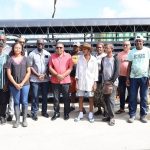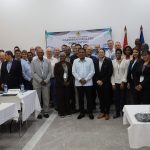Guyana has long been touted as having the potential to become the bread basket of the Caribbean. But, for decades the dream has been elusive. With its available, vast, arable lands and water sources, one is faced with the question, “What is being done to realize the true potential of Guyana’s agricultural sector and safeguard the Region’s food supply?”
According to Guyana’s Minister of Agriculture, Noel Holder, the government’s thrust is threefold; to improve drainage and irrigation and rationalize agricultural production on the coastlands, to move agriculture inland in an effort to reduce crop loss due to flooding and, diversify production in this most important sector.
Crop development and diversification is the purview of the National Agricultural Research and Extension Institute (NAREI). For a number of years the Institute has been trying to develop new or modern technologies for the farming community especially as these relate to adaptation to climate change. Head of the institution, Dr. Udho Homenauth is cognizant that the Region’s food supply is threatened by rising sea levels. “In Guyana, we focus on food security as well as the export market. For any export market, it means we have to have food throughout the year, we have to be able to produce year ‘round,” Homenauth told the Government Information Agency.
NAREI has tested and recommended several farming practices new to Guyana’s agricultural sector, toward the achievement of year ‘round food production. Among the new farming practices is ‘Shade House Cultivation’.
Used to protect cultivated plants from excessive heat, insects and pests, and light or dryness, shade house cultivation employs a controlled environment so as to help the plant system to develop. This type of cultivation usually reduces the level of damage which can be caused to crops through environmental interaction.
The NAREI is also focusing on introducing crops which are not native to the Region but, form a large part of the Caribbean’s food import.
Research Assistant, Lauren Paddy, is integrally involved in experimenting with broccoli and cauliflower to assess their performance in tropical climatic conditions. From her reports, “they are doing quite well under the shade house cultivation and with proper management can be produced commercially.”
One of NAREI’s objectives is, to introduce and promote the use of technology among farmers. For the agency, shade house cultivation is covered under cultural diversification and environmental adaptation due to climate change.
The MMA/ADA is a semi-autonomous agency under the Ministry of Agriculture, governed by a Board of Directors. The Board is responsible for the formulation of policies for the efficient functioning and operations of the MMA/ADA.
The main goals of the MMA/ADA are to manage, operate and maintain all drainage and irrigation works in Region Five (Mahaica/Berbice) and to administer all State and Government lands for the benefit of farmers and residents and National Development.
Overall, the MMA/ADA supports nearly half of the national rice production, about 30-35% of all livestock (mostly cattle) production and, 10-15% of national sugar production. General Manager of the scheme, Aubrey Charles, credits the success of Region Five’s agriculture sector to the drainage and irrigation works put in place since the establishment of the MMA/ADA.
Situated within the MMA /ADA district is the Guyana Rice Development’s Board (GRDB), 610 acres research station. At this location, research is carried out for the development of varieties, soil fertility & plant nutrition (Agronomy), weed management, insect management (Entomology), disease management (Pathology), farm management & seed production.
On moving agriculture inland, the minister has identified areas critical to the success of the government’s plans for the agriculture sector. “The intermediate savannahs, which is located just behind the coast and the Rupununi savannahs are the two main areas identified to facilitate this move and new development.”
This is a rational choice as clearing forested lands would be contrary to Guyana’s forest preservation undertakings to counter the effects of climate change.
The quest to develop the intermediate savannahs is bolstered by the work of several agricultural agencies. Among the agencies that are driving the diversification are the Guyana Livestock Development Authority (GLDA) and the National Agricultural Research and Extension Institute (NAREI), the two most critical agencies within the agriculture sector.
At this point there is no complete development plan for the savannahs that provides results of feasibility studies and the kind of crops and life stock which can be produced. However, there are studies on the road system which needs to be put in place and the water resources availability.
Leading the charge for livestock development is the Guyana Livestock Development Authority (GLDA), headed by Nigel Cumberbatch. According to Cumberbatch the GLDA programme was responsible for bringing a number of breeds of cattle into Guyana.
The breeds located at the Authority’s research station at Ebini are the Brangus, which is now being tested probably for the first time at the Intermediate Savannahs location.
Decades ago the Ebini livestock station was one of the premier ranches not only in the Caribbean but in the world. In recent time, the GLDA has revamped its Ebini operations and is focusing on beef production and small ruminant.
In small ruminants, the focus is more on the black belly sheep and it is believed that the Ebini operations may be home to probably the largest population of pure bred black belly in the Caribbean.
On the cattle front, production is focused on the beef aspect of things. Currently, the diary sector is centralized along the coastland of Guyana more specifically the five coastal Regions stretching from Region two to Region Six.
The GLDA is working to move some of the farmers away from the Holstein that was traditionally the main dairy breed of animal and looking at utilizing the Brown Swiss and the Jersey breed of dairy cattle. These are more adapted to Guyana’s conditions and so they are being introduced to local dairy farmers. They are smaller animals which can fit better within the system and they give just as much milk. The use of Artificial Insemination programme has always been part of the GLDA’s overall livestock improvement programme and that programme is continuing particularly as it relates to making dairy breeds available to the farming community.
Speaking with the Government Information Agency on the future of the Ebini station, Holder said, “We plan to make it into a model demonstration station as the catalyst for development of the entire savannahs where we are going to fully exploit the 3,000 acres of improved pastures for cattle, our sheep and goats potential and of course horse potential will be developed so it will be a model for new ventures in the savannahs. It will have a source not only as an example of how things can be done and should be done but also as a source of planting material and seed material and things of that nature.”
After 50 year of independence, is Guyana now ready to realize her potential to feed the Caribbean and what would be the response of her fellow Caricom States?
With the 37th CARICOM Heads of Government Conference taking place in Guyana from July 4 – 6 one is left to see what will be the outcome of the expressed desire for the reduction of the almost US$4 Caribbean food import bill.





